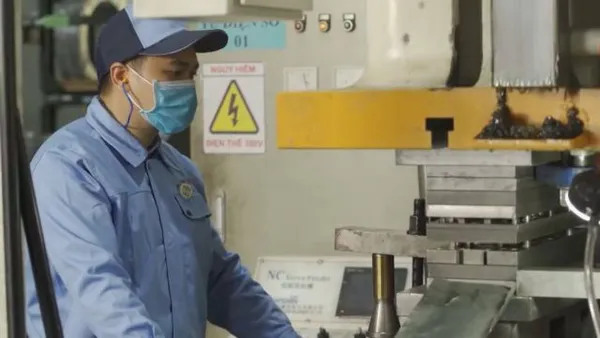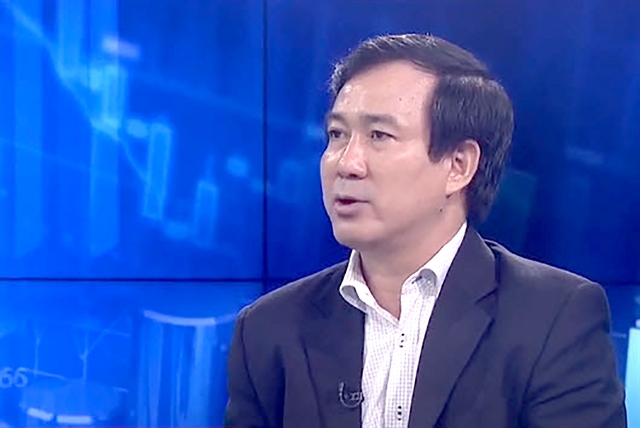 Economy
Economy


|
| Nguyễn Trung Tiến |
The General Statistics Office announced that the consumer price index (CPI) in April 2021 decreased by 0.04 per cent compared to the previous month, while many types of goods increased in price from the beginning of the year.
Nguyễn Trung Tiến, deputy director of the General Statistics Office (GSO), spoke to local media about this issue.
Since the beginning of the year, the prices of many types of goods and raw materials have increased. Why did GSO announce the CPI decreased in April 2021?
GSO reported on April 29 that April’s CPI decreased by 0.04 per cent over the previous month. But it increased by 1.27 per cent compared to December 2020 and 2.7 per cent year on year.
GSO confirmed that this result reflected the fluctuation of consumer price in the domestic market.
The monthly CPI is calculated based on information about prices of 752 kinds of goods and services at 40,000 price survey points in 63 provinces and centrally-run cities. Those goods and services represent consumption and are appropriate with the household consumption structure.
In April, four of 11 commodity and service groups that are used to calculate the national CPI decreased compared to the previous month. Meanwhile the six other groups had increased prices and only the apparel, hats, and footwear group remained stable.
However, the four groups with a price reduction accounted for 60.1 per cent of total goods and service volume, so it made the general price index of April decrease by 0.04 per cent compared to March.
The four groups of goods and services included the group of housing and construction materials, post and telecommunication services, food and catering services.
The six groups of goods and services with a price increase accounted for 34.2 per cent and the group of garments, hats and shoes with unchanged prices accounted for 5.7 per cent.
What method does Việt Nam use to calculate its CPI?
GSO has used the CPI calculation method according to the guidance of the International Labor Organisation (ILO) since 1995. That method is also the standard applied by most countries in the world. Now, Việt Nam is following the latest ILO Consumer Price Index Compilation Guide issued in 2020.
Therefore, the GSO’s CPI calculation method has reflected consumer price performance in the market and ensures comparability with other countries.
Every year, the International Monetary Fund (IMF) has sent experts to Việt Nam to review and evaluate information sources, calculation methods and representative items used to calculate CPI according to international standards.
Other international organisations such as the United Nations Statistics Office (UNSD), World Bank (WB), and Asian Development Bank (ADB) all use GSO's CPI data in their reports. They have assessed Viet Nam's CPI calculation method is consistent with international practices.
State agencies, universities, organisations, businesses and individuals all trust and regularly use CPI data in research and in production and business activities.
To calculate the CPI, the General Statistics Office identifies the list of popular consumer goods and services of the people, also known as a "basket" of goods. The total number of goods represented in the "basket" of goods in the period 2020-2025 is 752 items.
Based on the list of goods and services, 63 provinces and centrally-run cities build their own consumer price survey list for the calculation of CPI.
The prices are investigated at places trading in goods and services, including markets, trade centres and supermarkets.
Other investigation points include stalls, shops, service establishments, non-business units, schools, medical examination and treatment establishments.
Every month, 63 localities have collected information on prices from 40,000 survey points.
Then, the GSO will determine the structure of household expenditure based on this list of goods and services.
Now, GSO uses the Computer-Assisted Personal Interviews (CAPI) software to implement consumer price surveys. That helps to improve the quality of survey data, transparency of the investigation process, and shorten the time of investigation.
For special items such as electricity and domestic water, the GSO collects information on prices in accordance with international methodology and the advice of IMF experts.
We publish the consumer price index on the 29th of every month on the website of the General Statistics Office, including the CPI of the whole country, six economic regions and provinces and cities directly under the Central Government.
Experts say the world will face a wave of inflation. Could Việt Nam achieve the 4-per cent inflation target set by the National Assembly?
Viet Nam's average CPI in the first four months of this year increased by 0.89 per cent over the same period last year, the lowest four-month average growth rate since 2016. This is a favourable condition to control inflation for the whole year of 2021 as per the target.
However, there are some factors affecting control of inflation this year.
International organisations have made positive forecasts about the global economic outlook this year due to the implementation of COVID-19 vaccinations worldwide.
In Việt Nam, businesses are also adapting to a new normal state, so production activities, trade and services have gradually recovered and the demand for capital and raw materials has increased. When the economy recovers, the demand for goods and services increase, thereby pushing the price level up and putting pressure on inflation for the whole of 2021.
In addition, the price of raw materials in many fields increased sharply so the import of raw materials at high prices will affect production costs. That will push the prices of domestic consumer goods up.
Currently, world oil prices are still fluctuating, and are expected to increase 40 per cent compared to 2020. Therefore, the average domestic gasoline price this year may increase by 25 per cent, affecting the overall CPI of the year.
Countries continue to loosen monetary policy for economic recovery, creating higher demand that will push up commodity prices.
Therefore, in order to reduce inflationary pressure by the end of 2021 and sustainably control inflation in 2022, the State needs to closely monitor supply and demand, and prices of essential commodities.
They should take the initiative in controlling prices of goods managed by the State while ministries of Industry and Trade and Finance closely monitor world oil and gas prices and have reasonable use of the petroleum price stabilisation fund to limit the price increase of this commodity. — VNS